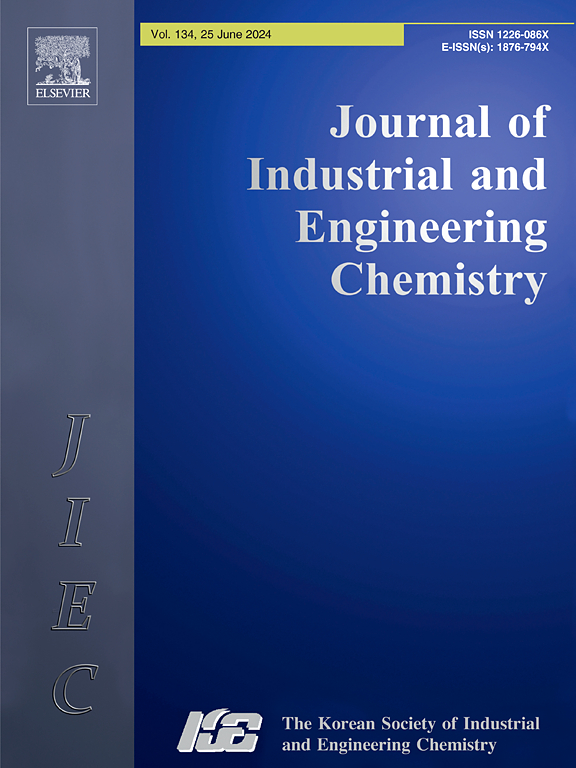The synergistic effect of carboxymethylated cellulose nanocrystals -Polyvinyl alcohol- L Arginine in facilitated transport membranes for biogas purification
IF 5.9
3区 工程技术
Q1 CHEMISTRY, MULTIDISCIPLINARY
Journal of Industrial and Engineering Chemistry
Pub Date : 2024-12-19
DOI:10.1016/j.jiec.2024.12.033
引用次数: 0
Abstract
Biogas can be used as a renewable energy source to mitigate the use of conventional fuels. However, for this to happen its quality must be improved. Herein biogas purification was carried out utilising membranes with a biodegradable selective layer of carboxymethylated cellulose nanocrystals (C-CNC)/ Polyvinyl alcohol (PVA)- L Arginine nanocomposite coated over highly porous poly(ether-sulfone) (PESF) hollow fibre substrate. Facilitated transport of CO2 aided by a mobile carrier (L-Arginine) and NaOH as carriers of CO2 in the hydrophilic C-CNC/PVA under high relative humidity is the principle of this separation process. Concentrations varying from 0-2 wt% of C-CNC in PVA-LA were considered for the study at 90 % RH and varying feed pressures of 0.8–1 bar. CO2 permeance and selectivity increased with the increase in C-CNC concentration till 1C-CNC/PVA-LA (1 wt% of C-CNC in PVA-LA) (6226 GPU permeance and selectivity of 19). At further higher C-CNC concentrations, a high chance of creating C-CNC-induced pathways through the selective layer could have created higher swelling, hence a reduction in CO2 permeance (5244 GPU) and reduced selectivity (11) for 2C-CNC/PVA-LA. Overall, a synergistic effect of the hydrophilicity induced by the C-CNC in PVA along with L-Arginine and NaOH for CO2 transport helped the attainment of biogas purification at low-pressure conditions.

羧甲基化纤维素纳米晶-聚乙烯醇-精氨酸在促进输送膜中对沼气净化的协同作用
沼气可以作为一种可再生能源来减少传统燃料的使用。然而,要做到这一点,就必须提高其质量。在本研究中,沼气净化是利用一层生物可降解的羧甲基化纤维素纳米晶体(C-CNC)/聚乙烯醇(PVA)- L精氨酸纳米复合材料包覆在高孔聚醚砜(PESF)中空纤维基底上的膜进行的。在高相对湿度条件下,以移动载体(l -精氨酸)和NaOH作为CO2载体在亲水性C-CNC/PVA中促进CO2的运输是该分离过程的原理。在90%相对湿度和0.8-1 bar的进料压力下,PVA-LA中C-CNC的浓度在0-2 wt%之间变化。随着C-CNC浓度的增加,CO2的渗透率和选择性增加,达到1C-CNC/PVA-LA (PVA-LA中C-CNC的1 wt%) (6226 GPU的渗透率和选择性为19)。在更高的C-CNC浓度下,通过选择层产生C-CNC诱导通路的可能性很大,可能会产生更高的膨胀,从而降低CO2渗透率(5244 GPU)和2C-CNC/PVA-LA的选择性(11)。总的来说,PVA中C-CNC诱导的亲水性与l -精氨酸和NaOH的协同作用有助于在低压条件下实现沼气净化。
本文章由计算机程序翻译,如有差异,请以英文原文为准。
求助全文
约1分钟内获得全文
求助全文
来源期刊
CiteScore
10.40
自引率
6.60%
发文量
639
审稿时长
29 days
期刊介绍:
Journal of Industrial and Engineering Chemistry is published monthly in English by the Korean Society of Industrial and Engineering Chemistry. JIEC brings together multidisciplinary interests in one journal and is to disseminate information on all aspects of research and development in industrial and engineering chemistry. Contributions in the form of research articles, short communications, notes and reviews are considered for publication. The editors welcome original contributions that have not been and are not to be published elsewhere. Instruction to authors and a manuscript submissions form are printed at the end of each issue. Bulk reprints of individual articles can be ordered. This publication is partially supported by Korea Research Foundation and the Korean Federation of Science and Technology Societies.

 求助内容:
求助内容: 应助结果提醒方式:
应助结果提醒方式:


